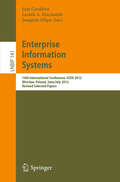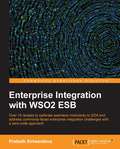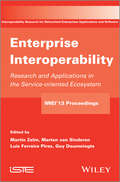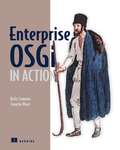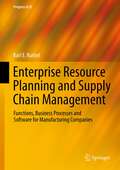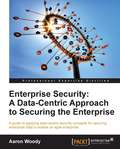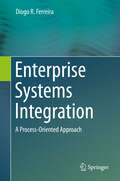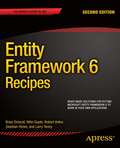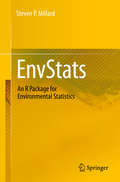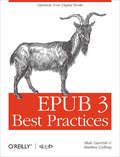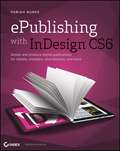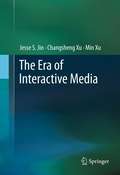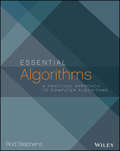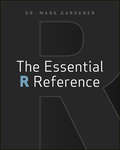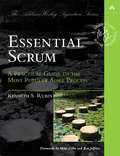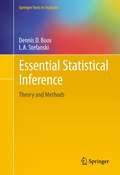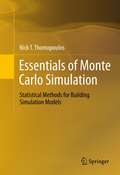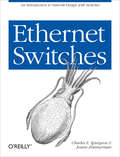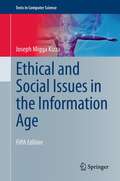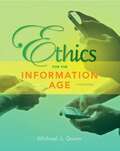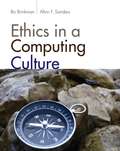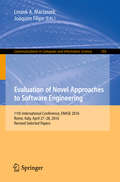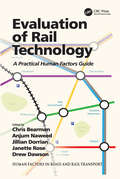- Table View
- List View
Enterprise Information Systems: 14th International Conference, ICEIS 2012, Wroclaw, Poland, June 28 - July 1, 2012, Revised Selected Papers (Lecture Notes in Business Information Processing #141)
by Leszek A. Maciaszek Joaquim Filipe José CordeiroThis book contains substantially extended and revised versions of the best papers from the 14th International Conference on Enterprise Information Systems (ICEIS 2012), held in Wroclaw, Poland, in June/July 2012.The 25 full and 3 invited papers included in this volume were carefully reviewed and selected from 299 submissions. They reflect state-of-the-art research work focusing mainly on real-world applications and highlighting the benefits of information systems and technology for industry and services, thus connecting academia with the world of real enterprises.The topics covered are: databases and information systems integration; artificial intelligence and decision support systems; information systems analysis and specification; software agents and internet computing; human-computer interaction; and enterprise architecture.Chapter “Time Efficiency of Point-of-Sale Payment Methods: Empirical Results for Cash, Cards and Mobile Payments” is available open access under a Creative Commons Attribution 4.0 International License via link.springer.com.
Enterprise Integration with WSO2 ESB
by Prabath SiriwardenaProviding background on the "when and why" of the topic, then diving into practical, instruction-based examples called "recipes", where each recipe will explain how to address a given challenge in enterprise integration.If you are an architect or Java developer, keen on building solutions to solve enterprise integration problems, this is the book for you!You will need a good understanding of SOA design concepts, SOAP, REST, and related messaging systems. However, you are not expected to be an advanced user of WSO2 ESB.
Enterprise Interoperability: Research and Applications in Service-oriented Ecosystem (Proceedings of the 5th International IFIP Working Conference IWIE 2013) (Lecture Notes In Business Information Processing Ser. #213)
by Martin Zelm Marten Van Sinderen Luis Ferraira Pires Guy DoumeingtsIn a fast changing global economy governed by Enterprise Services and the Future Internet, enterprises and virtual factories will self-organize in distributed, interoperable, innovation Ecosystems where the issues of Enterprise Interoperability need to be solved in a multi-view of information, services and processes throughout Enterprise Networks. The book constitutes the proceedings of five workshops co- located with the Fifth IFIP Working Conference IWEI 2013. It contains the presented peer reviewed papers and summaries of the workshop discussions. Complementing the IWEI Conference program, the workshops aimed at exploiting new issues, challenges and solutions for Enterprise Interoperability and Manufacturing Eco Systems. The scope of the workshops spanned over a range of interoperability issues in Service Science and innovation, Model Driven Service Engineering Architectures, Service Modelling Languages, reference ontology for manufacturing , Case studies and tools particularly for SMEs, Business – IT alignment and related Standardization. Contents 1 – Model Driven Services Engineering Architecture (MDSEA): A Result of MSEE Project An Architecture for Service Modelling in Servitization Context: MDSEA, Y. Ducq. A Set of Templates for MDSEA, D. Chen. 2 – Interoperability to Support Business–IT Alignment Report Workshop 2, I.-S. Fan, V. Taratoukhine, M. Matzner. Interoperability as a Catalyst for Business Innovation, J.H.P. Eloff, M.M. Eloff, M.T. Dlamini, E. Ngassam, D. Ras. Process-Oriented Business Modeling – An Application in the Printing Industry, A. Malsbender, K. Ortbach, R. Plattfaut, M. Voigt, B. Niehaves. A Comparative Study of Modelling Methodologies Using a Concept of Process Consistency, E. Babkin, E. Potapova, Y. Zelenova. Maintenance Support throughout the Life-Cycle of High Value Manufacturing Products. Interoperability Issues, A. Fedotova, V. Taratoukhine, Y. Kupriyanov. Using Enterprise Architecture to Align Business Intelligence Initiatives, I.-S. Fan, S. Warner. Towards Enterprise Architecture Using Solution Architecture Models, V. Agievich, R. Gimranov, V. Taratoukhine, J. Becker. 3 – Standardisation for Interoperability in the Service-Oriented Enterprise Report Workshop 3, M. Zelm, D. Chen. Standardisation in Manufacturing Service Engineering, M. Zelm, G. Doumeingts. Service Modelling Language and Potentials for a New Standard, D. Chen. An Approach to Standardise a Service Life Cycle Management, M. Freitag, D. Kremer, M. Hirsch, M. Zelm. Open Business Model, Process and Service Innovation with VDML and ServiceML, A. J. Berre, H. De Man, Y. Lew, B. Elvesæter, B.M. Ursin-Holm. Reference Ontologies for Manufacturing, R. Young, N. Hastilow, M. Imran, N. Chungoora, Z. Usman, A.-F. Cutting-Decelle. Standardisation Tools for Negotiating Interoperability Solutions, T. Santos, C. Coutinho, A. Cretan, M. Beca, R. Jardim-Goncalves. 4 – Case Studies on Enterprise Interoperability: How IT Managers Profit from EI Research Report Workshop 4, S. Kassel. Experiences of Transferring Approaches of Interoperability into SMEs, F. Gruner, S. Kassel. 5 – Selected New Applications of Enterprise Interoperability . 179 Report Workshop 5, L. Ferreira Pires, P. Johnson. Service-Oriented Enterprise Interoperability in Logistics, W. Hofman. An Ontological Approach to Logistics, L. Daniele, L. Ferreira Pires. Social Vision of Collaboration of Organizations on a Cloud Platform, A. Montarnal, W. Mu, F. Bénaben, A.-M. Barthe-Delanoë, J. Lamothe. Semantic Standards Quality Measured for Achieving Enterprise Interoperability: The Case of the SETU Standard for Flexible Staffing, E. Folmer, H. Wu. Re
Enterprise OSGi In Action
by Holly Cummins Timothy WardSummaryEnterprise OSGI in Action is a hands-on guide for developers using OSGi to build the next generation of enterprise Java applications. By presenting relevant examples and case studies, this book guides the reader through the maze of new standards and projects.About This BookEnterprise OSGi is a set of standards for building modular Java applications which integrate seamlessly with existing Java EE technologies. It extends the OSGi component framework to distributed systems.Enterprise OSGi in Action is a hands-on guide for developers using OSGi to build enterprise Java applications. Many examples and case studies show you how to build, test, and deploy modular web applications. The book explains how to take advantage of dynamism, distribution, and automatic dependency provisioning, while still integrating with existing Java EE applications.The book is written for Java EE developers. No prior experience with OSGi is required.What's InsideBuild modular applications using servlets, JSPs, WARs, and JPABetter component reuse and robustnessExpert tips for Apache AriesPurchase of the print book includes a free eBook in PDF, Kindle, and ePub formats from Manning Publications.About the AuthorsHolly Cummins and Tim Ward are lead engineers who regularlyspeak at developerWorks, Devoxx, JavaZone, and EclipseCon. Tim has written standards in both the OSGi Core and Enterprise Specifications and both authors are active Apache Aries committers.Table of ContentsPART 1 PROGRAMMING BEYOND HELLO WORLDOSGi and the enterprise—why now?Developing a simple OSGi-based web applicationPersistence pays offPackaging your enterprise OSGi applicationsPART 2 BUILDING BETTER ENTERPRISE OSGI APPLICATIONSBest practices for enterprise applicationsBuilding dynamic applications with OSGi servicesProvisioning and resolutionTools for building and testingIDE development toolsPART 3 INTEGRATING ENTERPRISE OSGI WITH EVERYTHING ELSEHooking up remote systems with distributed OSGiMigration and integrationCoping with the non-OSGi worldChoosing a stack
Enterprise Resource Planning and Supply Chain Management: Functions, Business Processes and Software for Manufacturing Companies
by Karl Eugen KurbelThis book is about running modern industrial enterprises with the help of information systems. Enterprise resource planning (ERP) is the core of business information processing. An ERP system is the backbone of most companies' information systems landscape. All major business processes are handled with the help of this system. Supply chain management (SCM) looks beyond the individual company, taking into account that enterprises are increasingly concentrating on their core competencies, leaving other activities to suppliers. With the growing dependency on the partners, effective supply chains have become as important for a company's success as efficient in-house processes. This book covers typical business processes and shows how these processes are implemented. Examples are presented using the leading systems on the market - SAP ERP and SAP SCM. In this way, the reader can understand how business processes are actually carried out "in the real world".
Enterprise Security: A Data-Centric Approach to Securing the Enterprise
by Aaron WoodyIt's a reference guide to enterprise security programs. This book is intended for the IT security staff beginner to expert but would also be a valuable resource for other IT functions such as IT compliance, IT operations, and executives responsible for managing IT and information security. Understanding the principles in this book is important for decision makers as new business models are developed and enterprise security must keep up to reduce risk and secure critical enterprise assets and data.
Enterprise Systems Integration
by Diogo R. FerreiraThe field of enterprise systems integration is constantly evolving, as every new technology that is introduced appears to make all previous ones obsolete. Despite this continuous evolution, there is a set of underlying concepts and technologies that have been gaining an increasing importance in this field. Examples are asynchronous messaging through message queues, data and application adapters based on XML and Web services, the principles associated with the service-oriented architecture (SOA), service composition, orchestrations, and advanced mechanisms such as correlations and long-running transactions. Today, these concepts have reached a significant level of maturity and they represent the foundation over which most integration platforms have been built. This book addresses integration with a view towards supporting business processes. From messaging systems to data and application adapters, and then to services, orchestrations, and choreographies, the focus is placed on the connection between systems and business processes, and particularly on how it is possible to develop an integrated application infrastructure in order to implement the desired business processes. For this purpose, the text follows a layered, bottom-up approach, with application-oriented integration at the lowest level, followed by service-oriented integration and finally completed by process-oriented integration at the topmost level. The presentation of concepts is accompanied by a set of instructive examples using state-of-the-art technologies such as Java Message Service (JMS), Microsoft Message Queuing (MSMQ), Web Services, Microsoft BizTalk Server, and the Business Process Execution Language (BPEL). The book is intended as a textbook for advance undergraduate or beginning graduate students in computer science, especially for those in an information systems curriculum. IT professionals with a background in programming, databases and XML will also benefit from the step-by-step description of the various integration levels and the related implementation examples.
Entity Framework 6 Recipes
by Brian Driscoll Nitin Gupta Rob Vettor Zeeshan Hirani Larry TennyEntity Framework6 Recipes provides an exhaustive collection of ready-to-use code solutions for Entity Framework, Microsoft'smodel-centric, data-access platform for the . NET Framework and ASP. NET development. With this book, you will learn the core concepts of Entity Framework through a broad range of clear and concise solutions to everyday data access tasks. Armed with this experience, you will be ready to dive deep into Entity Framework, experiment with new approaches, and develop ways to solve even the most difficult data access challenges. If you are a developer who likes to learn by example, then this is the right book for you. Gives ready-to-use, real-world recipes to help you with everyday tasks Places strong focus on DbContext and the Code First approach Covers new features such as Asynch Query and Save, Codebased Configuration, Connection Resiliency, Dependency Resolution, and much more "
EnvStats
by Steven P. MillardThis book describes EnvStats, a new comprehensive R package for environmental statistics and the successor to the S-PLUS module EnvironmentalStats for S-PLUS (first released in 1997). EnvStats and R provide an open-source set of powerful functions for performing graphical and statistical analyses of environmental data, bringing major environmental statistical methods found in the literature and regulatory guidance documents into one statistical package, along with an extensive hypertext help system that explains what these methods do, how to use these methods, and where to find them in the environmental statistics literature. EnvStats also includes numerous built-in data sets from regulatory guidance documents and the environmental statistics literature. This book shows how to use EnvStats and R to easily: * graphically display environmental data * plot probability distributions * estimate distribution parameters and construct confidence intervals on the original scale for commonly used distributions such as the lognormal and gamma, as well as do this nonparametrically * estimate and construct confidence intervals for distribution percentiles or do this nonparametrically (e. g. , to compare to an environmental protection standard) * perform and plot the results of goodness-of-fit tests * compute optimal Box-Cox data transformations * compute prediction limits and simultaneous prediction limits (e. g. , to assess compliance at multiple sites for multiple constituents) * perform nonparametric estimation and test for seasonal trend (even in the presence of correlated observations) * perform power and sample size computations and create companion plots for sampling designs based on confidence intervals, hypothesis tests, prediction intervals, and tolerance intervals * deal with non-detect (censored) data * perform Monte Carlo simulation and probabilistic risk assessment * reproduce specific examples in EPA guidance documents EnvStats combined with other R packages (e. g. , for spatial analysis) provides the environmental scientist, statistician, researcher, and technician with tools to "get the job done!"
Enyo: Up and Running
by Roy SuttonLearn how easy it is to design and build responsive, cross-platform apps with the Enyo open source JavaScript framework. With this hands-on book, Enyo contributor Roy Sutton shows you how to get started with the framework's core object-oriented features, including its modular design, reusable and extensible components, layout and widget libraries, easy-to-use deployment options, and support for HTML5 standards. Before you know it, you'll be writing native-quality apps that work equally well on smartphones, tablets, and desktops. Are you familiar with HTML, CSS, or JavaScript? Then you're ready for Enyo. Start with a sample project to get the feel of Enyo right away Learn about Enyo's "kinds" (component building blocks), encapsulation, inheritance, and other core features Design compelling and responsive apps with Enyo's layout strategies and Layout library Use existing components to create new components Build unique user interfaces with the Onyx library and widget set Explore the community gallery to find and share reusable components Tackle debugging, performance tuning, and globalization Package your app for web, desktop, and mobile targets, using Bootplate, AppUp, and PhoneGap
EPUB 3 Best Practices: Optimize Your Digital Books (Oreilly And Associate Ser.)
by Matt Garrish Markus GyllingReady to take your ebooks to the next level with EPUB 3? This concise guide includes best practices and advice to help you navigate the format's wide range of technologies and functionality. EPUB 3 is set to turn electronic publishing on its head with rich multimedia reading experiences and scripted interactivity, but this specification can be daunting to learn. This book provides you with a solid foundation. Written by people involved in the development of this specification, EPUB 3 Best Practices includes chapters that cover unique aspects of the EPUB publishing process, such as technology, content creation, and distribution. Get a comprehensive survey of accessible production features Learn new global language-support features, including right-to-left page progressions Embed content with EPUB 3's new multimedia elements Make your content dynamic through scripting and interactive elements Work with publication and distribution metadata Create synchronized text and audio playback in reading systems Learn techniques for fixed and adaptive layouts
ePublishing with InDesign CS6
by Pariah S. BurkeHere's the designer's guide to creating excellent e-books with InDesignCreative professionals are designing more and more e-books and e-zines as digital publishing increasingly gains market share. This book pulls together a wide range of essential information to help them maximize the versatility of InDesign for e-publishing. If you need to know how to build, deploy, and manage digital publications using InDesign, here's your guide to the process, from understanding the platforms and devices and how best to design for them to creating media-rich content for multiple formats using a variety of technologies.Designers are seeking to sharpen their skills to compete in today's e-publishing market, and this book is packed with necessary information about creating and adapting content for e-publication Explains how to plan a new digital publication, convert a print publication to digital, add multimedia and interactivity, and publish and distribute the finished product Covers platforms, devices, and formats; creating media-rich content; designing for different devices; and managing digital publications Examines Adobe's Digital Publishing System, CSS, HTML5, and other commercial vehicles available for e-publishing on multiple platforms, including iPad, Kindle, NOOK, and other tablets and e-readersePublishing with InDesign is a valuable tool for designers seeking to boost their skills and create cutting-edge e-publications.
The Era of Interactive Media
by Min Xu Jesse S. Jin Changsheng XuInteractive Media is a new research field and a landmark in multimedia development. The Era of Interactive Media is an edited volume contributed from world experts working in academia, research institutions and industry. The Era of Interactive Media focuses mainly on Interactive Media and its various applications. This book also covers multimedia analysis and retrieval; multimedia security rights and management; multimedia compression and optimization; multimedia communication and networking; and multimedia systems and applications. The Era of Interactive Media is designed for a professional audience composed of practitioners and researchers working in the field of multimedia. Advanced-level students in computer science and electrical engineering will also find this book useful as a secondary text or reference.
Essential Algorithms
by Rod StephensA friendly and accessible introduction to the most useful algorithmsComputer algorithms are the basic recipes for programming. Professional programmers need to know how to use algorithms to solve difficult programming problems. Written in simple, intuitive English, this book describes how and when to use the most practical classic algorithms, and even how to create new algorithms to meet future needs. The book also includes a collection of questions that can help readers prepare for a programming job interview. Reveals methods for manipulating common data structures such as arrays, linked lists, trees, and networksAddresses advanced data structures such as heaps, 2-3 trees, B-treesAddresses general problem-solving techniques such as branch and bound, divide and conquer, recursion, backtracking, heuristics, and moreReviews sorting and searching, network algorithms, and numerical algorithms Includes general problem-solving techniques such as brute force and exhaustive search, divide and conquer, backtracking, recursion, branch and bound, and moreIn addition, Essential Algorithms features a companion website that includes full instructor materials to support training or higher ed adoptions.
The Essential R Reference
by Mark GardenerAn essential library of basic commands you can copy and paste into RThe powerful and open-source statistical programming language R is rapidly growing in popularity, but it requires that you type in commands at the keyboard rather than use a mouse, so you have to learn the language of R. But there is a shortcut, and that's where this unique book comes in. A companion book to Visualize This: The FlowingData Guide to Design, Visualization, and Statistics, this practical reference is a library of basic R commands that you can copy and paste into R to perform many types of statistical analyses.Whether you're in technology, science, medicine, business, or engineering, you can quickly turn to your topic in this handy book and find the commands you need.Comprehensive command reference for the R programming language and a companion book to Visualize This: The FlowingData Guide to Design, Visualization, and StatisticsCombines elements of a dictionary, glossary, and thesaurus for the R languageProvides easy accessibility to the commands you need, by topic, which you can cut and paste into R as neededCovers getting, saving, examining, and manipulating data; statistical test and math; and all the things you can do with graphsAlso includes a collection of utilities that you'll find usefulSimplify the complex statistical R programming language with The Essential R Reference..
Essential Scrum: A Practical Guide to the Most Popular Agile Process
by Kenneth RubinEssential Scrum will provide every team member, manager, and executive with a common understanding of Scrum, a shared vocabulary they can use in applying it, and practical knowledge for deriving maximum value from it. Whether you are new to Scrum or years into your use, this book will introduce, clarify, and deepen your Scrum knowledge at the team, product, and portfolio levels. Drawing from Rubin’s experience helping hundreds of organizations succeed with Scrum, this book provides easy-to-digest descriptions enhanced by more than two hundred illustrations based on an entirely new visual icon language for describing Scrum’s roles, artifacts, and activities. Essential Scrum is the complete, single-source reference to develop innovative products and services that delight your customers.
Essential Statistical Inference
by Dennis D. Boos L A StefanskiThis book is for students and researchers who have had a first year graduate level mathematical statistics course. It covers classical likelihood, Bayesian, and permutation inference; an introduction to basic asymptotic distribution theory; and modern topics like M-estimation, the jackknife, and the bootstrap. R code is woven throughout the text, and there are a large number of examples and problems. An important goal has been to make the topics accessible to a wide audience, with little overt reliance on measure theory. A typical semester course consists of Chapters 1-6 (likelihood-based estimation and testing, Bayesian inference, basic asymptotic results) plus selections from M-estimation and related testing and resampling methodology. Dennis Boos and Len Stefanski are professors in the Department of Statistics at North Carolina State. Their research has been eclectic, often with a robustness angle, although Stefanski is also known for research concentrated on measurement error, including a co-authored book on non-linear measurement error models. In recent years the authors have jointly worked on variable selection methods.
Essentials of Monte Carlo Simulation
by Nick T. ThomopoulosEssentials of Monte Carlo Simulation focuses on the fundamentals of Monte Carlo methods using basic computer simulation techniques. The theories presented in this text deal with systems that are too complex to solve analytically. As a result, readers are given a system of interest and constructs using computer code, as well as algorithmic models to emulate how the system works internally. After the models are run several times, in a random sample way, the data for each output variable(s) of interest is analyzed by ordinary statistical methods. This book features 11 comprehensive chapters, and discusses such key topics as random number generators, multivariate random variates, and continuous random variates. Over 100 numerical examples are presented as part of the appendix to illustrate useful real world applications. The text also contains an easy to read presentation with minimal use of difficult mathematical concepts. Very little has been published in the area of computer Monte Carlo simulation methods, and this book will appeal to students and researchers in the fields of Mathematics and Statistics.
Ethernet Switches: An Introduction to Network Design with Switches
by Joann Zimmerman Charles E. SpurgeonIf you're ready to build a large network system, this handy excerpt from Ethernet: The Definitive Guide, Second Edition gets you up to speed on a basic building block: Ethernet switches. Whether you're working on an enterprise or campus network, data center, or Internet service provider network, you'll learn how Ethernet switches function and how they're used in network designs. This brief tutorial also provides an overview of the most important features found in switches, from the basics to more advanced features found in higher-cost and specialized switches. Get an overview of basic switch operation, the spanning tree protocol, and switch performance issues Learn about switch management and some of the most widely used switch features Discover how a hierarchical design can help maintain stable network operations Delve into special-purpose switches, such as multi-layer, access, stacking, and wireless access-point switches Learn about advanced switch features designed for specific networking environments Dive deeper into switches, with a list of protocol and package documentation
Ethical and Social Issues in the Information Age (Texts in Computer Science)
by Joseph Migga KizzaThis new edition examines the ethical, social, and policy challenges stemming from computing and telecommunication technology, and mobile information-enabling devices. Features: establishes a philosophical framework and analytical tools for discussing moral theories and problems in ethical relativism; offers pertinent discussions on privacy, surveillance, employee monitoring, biometrics, civil liberties, harassment, the digital divide, and discrimination; examines the new ethical, cultural and economic realities of computer social networks; reviews issues of property rights, responsibility and accountability relating to IT and software; discusses how virtualization technology informs ethical behavior; introduces the frontiers of ethics in VR, AI, and the Internet; surveys the social, moral and ethical value systems in mobile telecommunications; explores the evolution of electronic crime, network security, and computer forensics; provides exercises, objectives, and issues for discussion in every chapter.
Ethical and Social Issues in the Information Age, 5th Edition
by Joseph Migga KizzaThis new edition examines the ethical, social, and policy challenges stemming from computing and telecommunication technology, and mobile information-enabling devices. Features: establishes a philosophical framework and analytical tools for discussing moral theories and problems in ethical relativism; offers pertinent discussions on privacy, surveillance, employee monitoring, biometrics, civil liberties, harassment, the digital divide, and discrimination; examines the new ethical, cultural and economic realities of computer social networks; reviews issues of property rights, responsibility and accountability relating to IT and software; discusses how virtualization technology informs ethical behavior; introduces the frontiers of ethics in VR, AI, and the Internet; surveys the social, moral and ethical value systems in mobile telecommunications; explores the evolution of electronic crime, network security, and computer forensics; provides exercises, objectives, and issues for discussion in every chapter.
Ethics For The Information Age
by Michael J. QuinnThis book is appropriate for any standalone “computers and society” or “computer ethics” course offered by a computer science, business, or philosophy department, as well as special "modules" in any advanced CS course. In an era where information technology changes constantly, a thoughtful response to these rapid changes requires a basic understanding of IT history, an awareness of current issues, and a familiarity with ethics. Ethics for the Information Age is unique in its balanced coverage of ethical theories used to analyze problems encountered by computer professionals in today’s environment. By presenting provocative issues such as social networking, government surveillance, and intellectual property from all points of view, this market-leading text challenges students to think critically and draw their own conclusions, which ultimately prepares them to become responsible, ethical users of future technologies.
Ethics in a Computing Culture
by Bo Brinkman Alton F. SandersETHICS IN A COMPUTING CULTURE introduces key ideas in moral theory and professionalism to explore the hottest topics in computer ethics. With a unique blend of theory, application, and critical thinking exercises, each chapter underscores the interdisciplinary links between computing and diverse areas of study. Abundant multicultural cases are presented throughout to highlight contrasts and conflicts in ethical perspectives across the globe. ETHICS IN A COMPUTING CULTURE encourages students to continually read, reflect and write to hone sharp critical thinking skills. Students learn that that computing is not a purely technical discipline but one with moral and social implications that affect everyday life.
Evaluation of Novel Approaches to Software Engineering
by Leszek A. Maciaszek Joaquim FilipeThis book constitutes the thoroughly refereed proceedings of the 8th International Conference on Evaluation of Novel Approaches to Software Engineering, ENASE 2013, held in Angers, France, in July 2013. The 18 full papers presented were carefully reviewed and selected from 46 submissions. The papers reflect a growing effort to increase the dissemination of new results among researchers and professionals related to evaluation of novel approaches to software engineering. By comparing novel approaches with established traditional practices and by evaluating them against software quality criteria, the ENASE conferences advance knowledge and research in software engineering, identify most hopeful trends, and propose new directions for consideration by researchers and practitioners involved in large-scale software development and integration.
Evaluation of Rail Technology: A Practical Human Factors Guide (Human Factors in Road and Rail Transport)
by Anjum Naweed Jillian Dorrian Janette RoseRapid advancements in train control and in-cab technologies provide significant opportunities for rail operators to improve efficiency and enhance their operations. New technologies often provide elegant solutions to existing problems or new capabilities for the operator. However, new technologies may also represent a significant form of risk. Thus, it is important to balance the potential for significant improvement with justifiable concern about how the technology may unpredictably change the nature of the work. If a technology is designed and implemented without considering the substantive human factors concerns, that technology may lead to unintended consequences that can introduce safety issues and disrupt network performance. It is important to note that even a well-designed and beneficial technology may be rejected by the users who see it as a threat to their jobs, status or working conditions. This book discusses the issues surrounding rail technology and introduces a ’toolkit’ of human factors evaluation methods. The toolkit provides a practical and operationally focused set of methods that can be used by managers considering investing in technology, staff charged with implementing a technology, and consultants engaged to assist with the design and evaluation process. This toolkit can help to ensure that new rail technologies are thoughtfully designed, effectively implemented, and well received by users so that the significant investment associated with developing rail technologies is not wasted.
